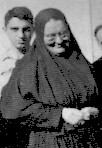[/caption]
and being the servant of one’s neighbor in the world. Through his life and writings, we can see a Christian who does not cloister his faith, but makes faith alive in service to humanity. For Bukharev, a faith alive was one that had a social context to alleviate suffering in the earthly world. As Behr-Sigel says: “Bukharev’s approach was the integral connection between this ‘mystical theology’ and the concern for a compassionate, actively creative and transforming presence in the world.” The Monk in the City as Elisabeth titles her essay elucidates a life of service linked with a profound spiritual empting of one’s self to express the love of Christ. This theology expresses “worship of the living God through service to others” is evocative of the life of Mother Teresa of Calcutta.
The proceeding chapter focuses on the story of Mother Maria Skobtsova (1891-1945)a spiritual inheritor of the theology of Bukharev. Born in Latvia, her name in the world was Elisabeth Pilenko. She became a politically active Socialist in Russia around the time of the revolution; escaping to Paris with her husband. In Paris, she became involved with the Russian Students Movement and became friends with many of the Russian theological intelligentsia. Sergius Bulgakov became her father confessor. A theologian, poet and social worker she petitioned her bishop to take up the habit. She was professed and was given the monastic name Maria.
[caption id="attachment_332" align="alignright" width="102" caption="Mother Maria of Paris"] [/caption]
She strongly wished to continue a monasticism open to the world in the manner of Alexander Bukharev. In the 1930s she reached out to the suffering poor of Paris. A controversial socially active monasticism caused a scandal with more conservative church members, but Mother Maria endured. With the advent of World War II, Mother Maria and her friends reached out to help Jews hide and escape Nazi persecution. She was betrayed to the Germans and was put to death, taking the place of a young girl scheduled to die in the gas chambers. Her martyrdom took place in the last days of the war in Ravensbruck concentration camp; On January 18, 2004, the Holy Synod of the Ecumenical Patriarchate in Istanbul recognized Mother Maria Skobtsova as a saint along with her son Yuri, the priest who worked closely with her, Fr. Dimitri Klépinin, and her close friend and collaborator Ilya Fondaminsky. All four died in German concentration camps. On January 18, 2004, the Holy Synod of the Ecumenical Patriarchate in Istanbul recognized Mother Maria Skobtsova as a saint along with her son Yuri, the priest who worked closely with her, Fr. Dimitri Klépinin, and her close friend and collaborator Ilya Fondaminsky.]]>
[/caption]
She strongly wished to continue a monasticism open to the world in the manner of Alexander Bukharev. In the 1930s she reached out to the suffering poor of Paris. A controversial socially active monasticism caused a scandal with more conservative church members, but Mother Maria endured. With the advent of World War II, Mother Maria and her friends reached out to help Jews hide and escape Nazi persecution. She was betrayed to the Germans and was put to death, taking the place of a young girl scheduled to die in the gas chambers. Her martyrdom took place in the last days of the war in Ravensbruck concentration camp; On January 18, 2004, the Holy Synod of the Ecumenical Patriarchate in Istanbul recognized Mother Maria Skobtsova as a saint along with her son Yuri, the priest who worked closely with her, Fr. Dimitri Klépinin, and her close friend and collaborator Ilya Fondaminsky. All four died in German concentration camps. On January 18, 2004, the Holy Synod of the Ecumenical Patriarchate in Istanbul recognized Mother Maria Skobtsova as a saint along with her son Yuri, the priest who worked closely with her, Fr. Dimitri Klépinin, and her close friend and collaborator Ilya Fondaminsky.]]>

Father George Bithos' weblog